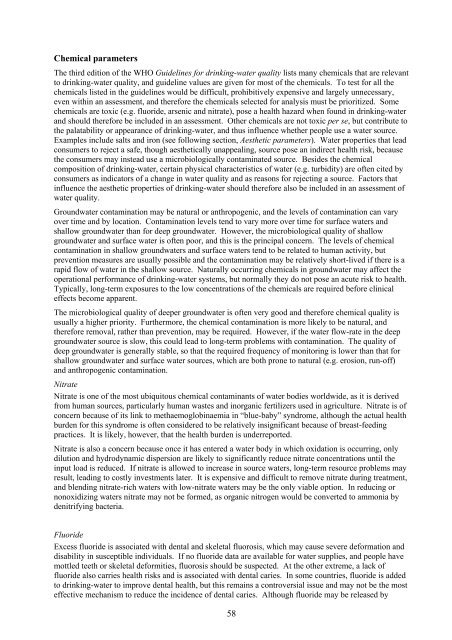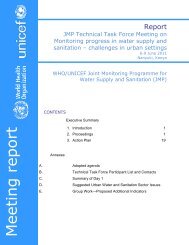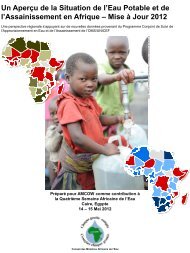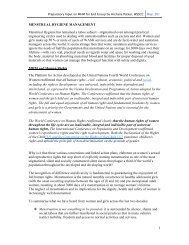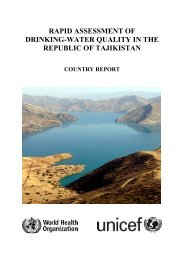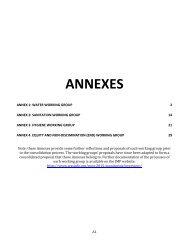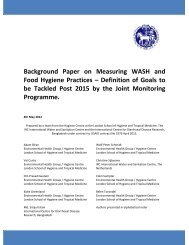Rapid assessment of drinking-water quality in the - WHO/UNICEF ...
Rapid assessment of drinking-water quality in the - WHO/UNICEF ...
Rapid assessment of drinking-water quality in the - WHO/UNICEF ...
You also want an ePaper? Increase the reach of your titles
YUMPU automatically turns print PDFs into web optimized ePapers that Google loves.
Chemical parameters<br />
The third edition <strong>of</strong> <strong>the</strong> <strong>WHO</strong> Guidel<strong>in</strong>es for <strong>dr<strong>in</strong>k<strong>in</strong>g</strong>-<strong>water</strong> <strong>quality</strong> lists many chemicals that are relevant<br />
to <strong>dr<strong>in</strong>k<strong>in</strong>g</strong>-<strong>water</strong> <strong>quality</strong>, and guidel<strong>in</strong>e values are given for most <strong>of</strong> <strong>the</strong> chemicals. To test for all <strong>the</strong><br />
chemicals listed <strong>in</strong> <strong>the</strong> guidel<strong>in</strong>es would be difficult, prohibitively expensive and largely unnecessary,<br />
even with<strong>in</strong> an <strong>assessment</strong>, and <strong>the</strong>refore <strong>the</strong> chemicals selected for analysis must be prioritized. Some<br />
chemicals are toxic (e.g. fluoride, arsenic and nitrate), pose a health hazard when found <strong>in</strong> <strong>dr<strong>in</strong>k<strong>in</strong>g</strong>-<strong>water</strong><br />
and should <strong>the</strong>refore be <strong>in</strong>cluded <strong>in</strong> an <strong>assessment</strong>. O<strong>the</strong>r chemicals are not toxic per se, but contribute to<br />
<strong>the</strong> palatability or appearance <strong>of</strong> <strong>dr<strong>in</strong>k<strong>in</strong>g</strong>-<strong>water</strong>, and thus <strong>in</strong>fluence whe<strong>the</strong>r people use a <strong>water</strong> source.<br />
Examples <strong>in</strong>clude salts and iron (see follow<strong>in</strong>g section, Aes<strong>the</strong>tic parameters). Water properties that lead<br />
consumers to reject a safe, though aes<strong>the</strong>tically unappeal<strong>in</strong>g, source pose an <strong>in</strong>direct health risk, because<br />
<strong>the</strong> consumers may <strong>in</strong>stead use a microbiologically contam<strong>in</strong>ated source. Besides <strong>the</strong> chemical<br />
composition <strong>of</strong> <strong>dr<strong>in</strong>k<strong>in</strong>g</strong>-<strong>water</strong>, certa<strong>in</strong> physical characteristics <strong>of</strong> <strong>water</strong> (e.g. turbidity) are <strong>of</strong>ten cited by<br />
consumers as <strong>in</strong>dicators <strong>of</strong> a change <strong>in</strong> <strong>water</strong> <strong>quality</strong> and as reasons for reject<strong>in</strong>g a source. Factors that<br />
<strong>in</strong>fluence <strong>the</strong> aes<strong>the</strong>tic properties <strong>of</strong> <strong>dr<strong>in</strong>k<strong>in</strong>g</strong>-<strong>water</strong> should <strong>the</strong>refore also be <strong>in</strong>cluded <strong>in</strong> an <strong>assessment</strong> <strong>of</strong><br />
<strong>water</strong> <strong>quality</strong>.<br />
Ground<strong>water</strong> contam<strong>in</strong>ation may be natural or anthropogenic, and <strong>the</strong> levels <strong>of</strong> contam<strong>in</strong>ation can vary<br />
over time and by location. Contam<strong>in</strong>ation levels tend to vary more over time for surface <strong>water</strong>s and<br />
shallow ground<strong>water</strong> than for deep ground<strong>water</strong>. However, <strong>the</strong> microbiological <strong>quality</strong> <strong>of</strong> shallow<br />
ground<strong>water</strong> and surface <strong>water</strong> is <strong>of</strong>ten poor, and this is <strong>the</strong> pr<strong>in</strong>cipal concern. The levels <strong>of</strong> chemical<br />
contam<strong>in</strong>ation <strong>in</strong> shallow ground<strong>water</strong>s and surface <strong>water</strong>s tend to be related to human activity, but<br />
prevention measures are usually possible and <strong>the</strong> contam<strong>in</strong>ation may be relatively short-lived if <strong>the</strong>re is a<br />
rapid flow <strong>of</strong> <strong>water</strong> <strong>in</strong> <strong>the</strong> shallow source. Naturally occurr<strong>in</strong>g chemicals <strong>in</strong> ground<strong>water</strong> may affect <strong>the</strong><br />
operational performance <strong>of</strong> <strong>dr<strong>in</strong>k<strong>in</strong>g</strong>-<strong>water</strong> systems, but normally <strong>the</strong>y do not pose an acute risk to health.<br />
Typically, long-term exposures to <strong>the</strong> low concentrations <strong>of</strong> <strong>the</strong> chemicals are required before cl<strong>in</strong>ical<br />
effects become apparent.<br />
The microbiological <strong>quality</strong> <strong>of</strong> deeper ground<strong>water</strong> is <strong>of</strong>ten very good and <strong>the</strong>refore chemical <strong>quality</strong> is<br />
usually a higher priority. Fur<strong>the</strong>rmore, <strong>the</strong> chemical contam<strong>in</strong>ation is more likely to be natural, and<br />
<strong>the</strong>refore removal, ra<strong>the</strong>r than prevention, may be required. However, if <strong>the</strong> <strong>water</strong> flow-rate <strong>in</strong> <strong>the</strong> deep<br />
ground<strong>water</strong> source is slow, this could lead to long-term problems with contam<strong>in</strong>ation. The <strong>quality</strong> <strong>of</strong><br />
deep ground<strong>water</strong> is generally stable, so that <strong>the</strong> required frequency <strong>of</strong> monitor<strong>in</strong>g is lower than that for<br />
shallow ground<strong>water</strong> and surface <strong>water</strong> sources, which are both prone to natural (e.g. erosion, run-<strong>of</strong>f)<br />
and anthropogenic contam<strong>in</strong>ation.<br />
Nitrate<br />
Nitrate is one <strong>of</strong> <strong>the</strong> most ubiquitous chemical contam<strong>in</strong>ants <strong>of</strong> <strong>water</strong> bodies worldwide, as it is derived<br />
from human sources, particularly human wastes and <strong>in</strong>organic fertilizers used <strong>in</strong> agriculture. Nitrate is <strong>of</strong><br />
concern because <strong>of</strong> its l<strong>in</strong>k to methaemoglob<strong>in</strong>aemia <strong>in</strong> “blue-baby” syndrome, although <strong>the</strong> actual health<br />
burden for this syndrome is <strong>of</strong>ten considered to be relatively <strong>in</strong>significant because <strong>of</strong> breast-feed<strong>in</strong>g<br />
practices. It is likely, however, that <strong>the</strong> health burden is underreported.<br />
Nitrate is also a concern because once it has entered a <strong>water</strong> body <strong>in</strong> which oxidation is occurr<strong>in</strong>g, only<br />
dilution and hydrodynamic dispersion are likely to significantly reduce nitrate concentrations until <strong>the</strong><br />
<strong>in</strong>put load is reduced. If nitrate is allowed to <strong>in</strong>crease <strong>in</strong> source <strong>water</strong>s, long-term resource problems may<br />
result, lead<strong>in</strong>g to costly <strong>in</strong>vestments later. It is expensive and difficult to remove nitrate dur<strong>in</strong>g treatment,<br />
and blend<strong>in</strong>g nitrate-rich <strong>water</strong>s with low-nitrate <strong>water</strong>s may be <strong>the</strong> only viable option. In reduc<strong>in</strong>g or<br />
nonoxidiz<strong>in</strong>g <strong>water</strong>s nitrate may not be formed, as organic nitrogen would be converted to ammonia by<br />
denitrify<strong>in</strong>g bacteria.<br />
Fluoride<br />
Excess fluoride is associated with dental and skeletal fluorosis, which may cause severe deformation and<br />
disability <strong>in</strong> susceptible <strong>in</strong>dividuals. If no fluoride data are available for <strong>water</strong> supplies, and people have<br />
mottled teeth or skeletal deformities, fluorosis should be suspected. At <strong>the</strong> o<strong>the</strong>r extreme, a lack <strong>of</strong><br />
fluoride also carries health risks and is associated with dental caries. In some countries, fluoride is added<br />
to <strong>dr<strong>in</strong>k<strong>in</strong>g</strong>-<strong>water</strong> to improve dental health, but this rema<strong>in</strong>s a controversial issue and may not be <strong>the</strong> most<br />
effective mechanism to reduce <strong>the</strong> <strong>in</strong>cidence <strong>of</strong> dental caries. Although fluoride may be released by<br />
58


